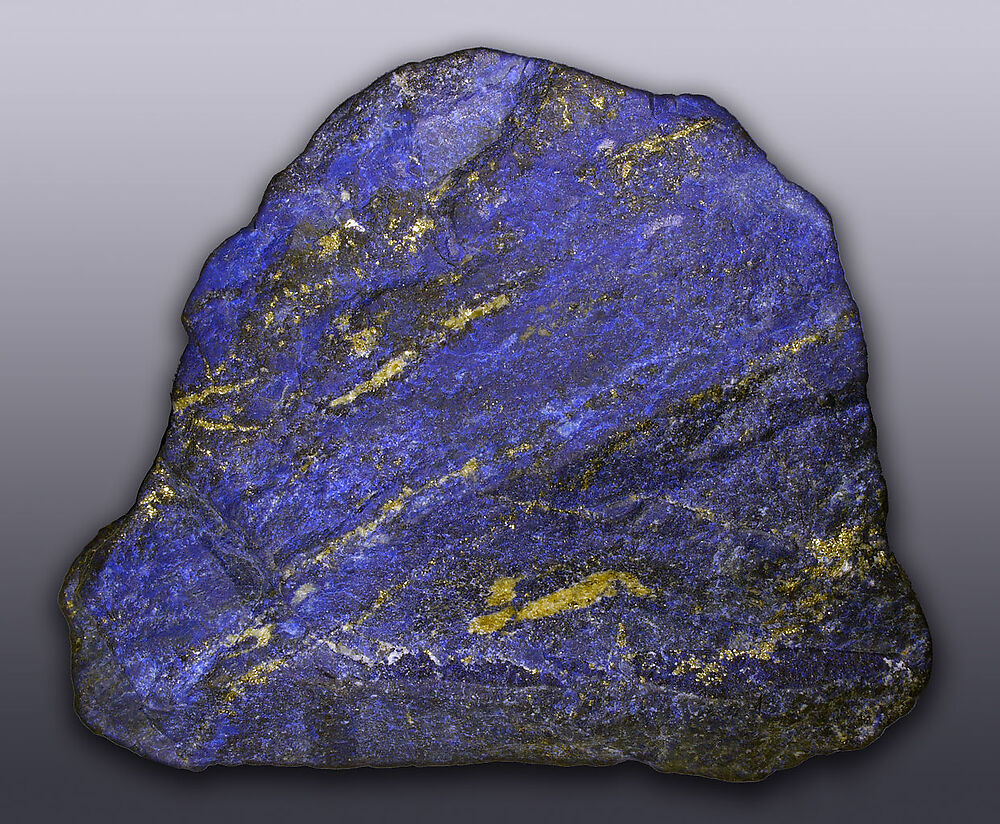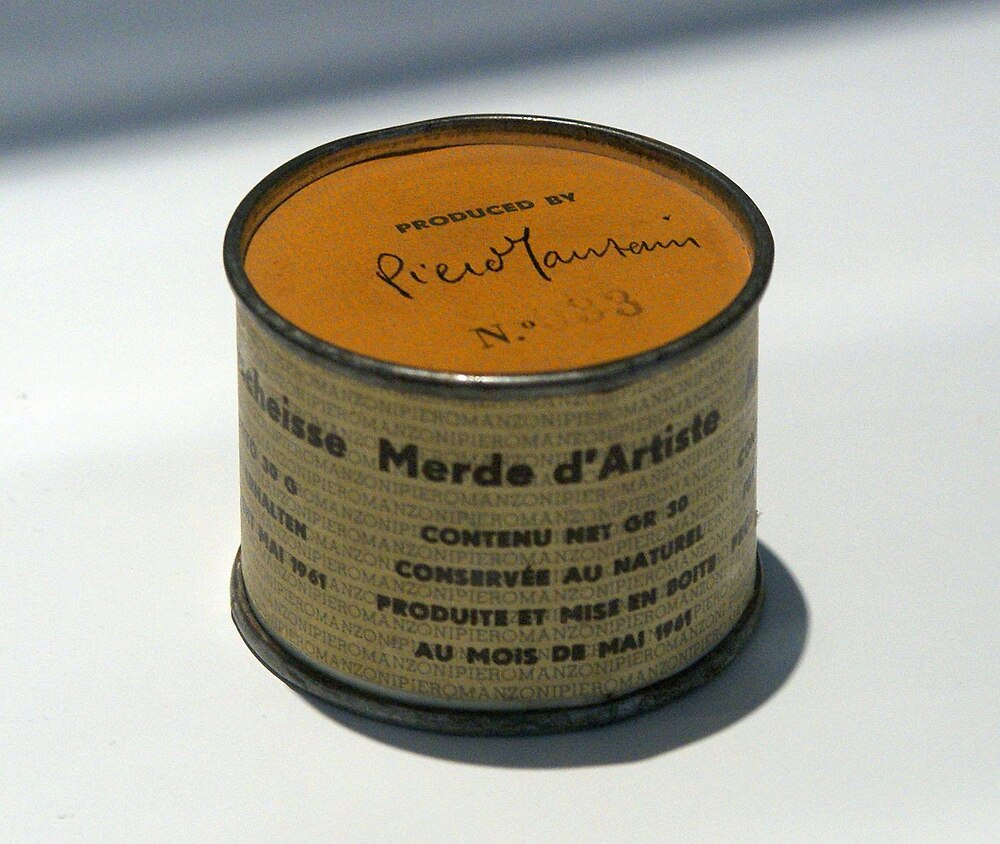Nowadays, art pricing can be confusing, as the price of an artwork isn’t necessarily correlated to a certain skillset, effort or subject.
We put into perspective traditional and modern perceptions of art, and propose a few pricing criteria, that can be weight so as to capture both ancient and present mindsets.

The Virgin in Prayer, 1640-1650. National Gallery, London.
by
Giovanni Battista Salvi da Sassoferrato
Perspective
Paint is mostly composed of two elements: pigments tied by a binder. As examples, in oil paint, linseed oil is a typical binder, so is gum arabic in watercolor.
Pigments are made by grinding materials to fine powders. Such materials range from burnt bones (ivory black), iron oxides (think, rust, ochres) to lapis lazuli.

Lapis lazuli with pyrite, Afghanistan (2008)
by
Hannes Grobe
Lapis lazuli, when used as a pigment, is referred to as ultramarine blue, from latin ultramarinus, “beyond the sea”, as it was imported from Afghanistan to Europe.
As if not sufficiently hard to get during the Renaissance, the pigment needed to be carefully prepared, as exposed by Cennino Cennini in Chapter LXII of his Il libro dell’arte:
To begin with, get some lapis lazuli. And if you want to recognize the good stone, choose that which you see is richest in blue color, because it is all mixed like ashes. That which contains least of this ash color is the best. But see that it is not the azurite stone, which looks very lovely to the eye, and resembles an enamel.
Pound it in a bronze mortar, covered up, so that it may not go off in dust; then put it on your porphyry slab, and work it up without water. Then take a covered sieve such as the druggists use for sifting drugs; and sift it, and pound it over again as you find necessary. And bear in mind that the more finely you work it up, the finer the blue will come out, but not so beautifully violet in color. It is true that the fine kind is more useful to illuminators, and for making draperies with lights on them.
When you have this powder all ready, get six ounces of pine rosin from the druggists, three ounces of gum mastic, and three ounces of new wax, for each pound of lapis lazuli; put all these things into a new pipkin, and melt them up together. Then take a white linen cloth, and strain these things into a glazed washbasin. Then take a pound of the lapis lazuli powder, and mix it all up thoroughly, and make a plastic of it, all incorporated together. And have some linseed oil, and always keep your hands well greased with this oil, so as to be able to handle the plastic. You must keep this plastic for at least three days and three nights, working it over a little every day; and bear in mind that you may keep it in the plastic for two weeks or a month, or as long as you like.
When you want to extract the blue from it, adopt this method. Make two sticks out of a stout rod, neither too thick nor too thin; and let them each be a foot long; and have them well rounded at the top and bottom, and nicely smoothed. And then have your plastic in the glazed washbasin where you have been keeping it; and put into it about a porringerful of lye, fairly warm; and with these two sticks, one in each hand, turn over and squeeze and knead this plastic, this way and that, just as you work over bread dough with your hand, in just the same way. When you have done this until you see that the lye is saturated with blue, draw it off into a glazed porringer. Then take as much lye again, and put it on to the plastic, and work it over with these sticks as before. When the lye has turned quite blue, put it into another glazed porringer, and put as much lye again on to the plastic, and press it out again in the usual way. And when the lye is quite blue, put it into another glazed porringer. And go on doing this for several days in the same way, until the plastic will no longer color the lye; and then throw it away, for it is no longer any good.
Then arrange all these porringers in front of you on a table, in series: that is, the yields, first, second, third, fourth, arranged in succession; and with your hand stir up in each one the lye with the blue which, on account of the heaviness of this blue, will have gone to the bottom; and then you will learn the yields of the blue. Weigh the question of how many grades of blue you want: whether three or four, or six, or however many you want; bearing in mind that the first yields are the best, just as the first porringer is better than the second.
And so, if you have eighteen porringers of the yields, and you wish to make three grades of blue, you take six of the porringers and mix them together, and reduce it to one porringer; and that will be one grade. And in the same way with the others. But bear in mind that if you have good lapis lazuli, the blue from the first two yields will be worth eight ducats an ounce. The last two yields are worse than ashes: therefore be prudent in your observation, so as not to spoil the first blues for the poor ones.
And every day drain off the lye from the porringers, until the blues are dry. When they are perfectly dry, do them up in leather, or in bladders, or in purses, according to the divisions which you have.And know that if that lapis lazuli stone was not so very good, or if you worked the stone up so much that the blue did not come out violet, I will teach you how to give it a little color. Take a bit of pounded kermes and a little brazil; cook them together; but either grate the brazil or scrape it with glass; and then cook them together with lye and a little rock alum; and when they boil you will see that it is a perfect crimson color. Before you take the blue out of the porringer, but after it is quite dry of the lye, put a little of this kermes and brazil on it; and stir it all up well with your finger; and let it stand until it dries, without sun, fire, or wind. When you find that it is dry, put it in leather, or in a purse, and leave it alone, for it is good and perfect.
And keep it to yourself, for it is an unusual ability to know how to make it properly. And know that making it is an occupation for pretty girls rather than for men; for they are always at home, and reliable, and they have more dainty hands. Just beware of old women1. When you get around to wanting to use some of this blue, take as much of it as you need. And if you have draperies with lights on them to execute, it ought to be worked up a little on the regular stone.
And if you want it just for laying in, it wants to be worked over on the stone very, very lightly, always using perfectly clear water, and keeping the stone well washed and clean. And if the blue should get soiled in any way, take a little lye, or clear water; and put it into the dish, and stir it up well; and you will do this two or three times, and the blue will be purified entirely.
I am not discussing its temperas for you, because I shall be showing you about all the temperas for all the colors later on, for panel, wall, iron, parchment, stone, and glass.
For those reasons, the pigment was reserved for the finest subjects, typically for the Virgin’s robe:

The Virgin, oil on canvas
by
Giovanni Battista Salvi da Sassoferrato
Progresses in chemistry allowed in 1826 the production of a synthetic version, reducing the price, augmenting the availability. Industrialization furthermore removed the need for hand-ground pigments, and more generally, for artists to prepare their own paints.
The progressive abandonment of religion lessened the interest in religious subjects, and likely helped to shift mentalities enough to give birth to previously unthinkable forms of “art”:

Piero Manzoni’s Merda d’artista, 1961
by
Jens Cederskjold
Such a can of maybe-literal faeces has been sold for 275 000€ in 2016. In the meantime, plenty of modern artworks essentially are huge checks:
The word “art” comes from Latin ars, meaning “skill, craft”, perfectly reflected in the lapis lazuli example. The same kind of meaning is also encoded in Chinese language:
(If you need help with the previous panel, you may want to head over here or over here)
Interestingly, it now means the exact opposite, as anything can be considered art.
Pricing criteria
Pricing should theoretically be quite similar to what could be expected from any artisanal product:
- artist’s notoriety and skillset;
- skillset and artwork’s scarcity;
- artwork’s subject;
- material qualities (durability, scarcity, etc.).
Unique, durable, highly crafted works expressing fine ideas by renowned crafstmen should sell at high price. Generic, disposable, rushed works merely expressing anything of value, by random persons, should sell at a low price.
While those criteria are mostly objective, their relative weight is more subjective: the rare portrait of a deceased family member, even if technically average, is likely to have more value that a finely crafted portrait of a stranger. The same goes for a landscape painting of a place special to someone.
Modern pricing is mostly unbalanced, strongly leaning toward artists’ notoriety.
-
One can but wonder… ↩︎
Comments
By email, at mathieu.bivert chez: